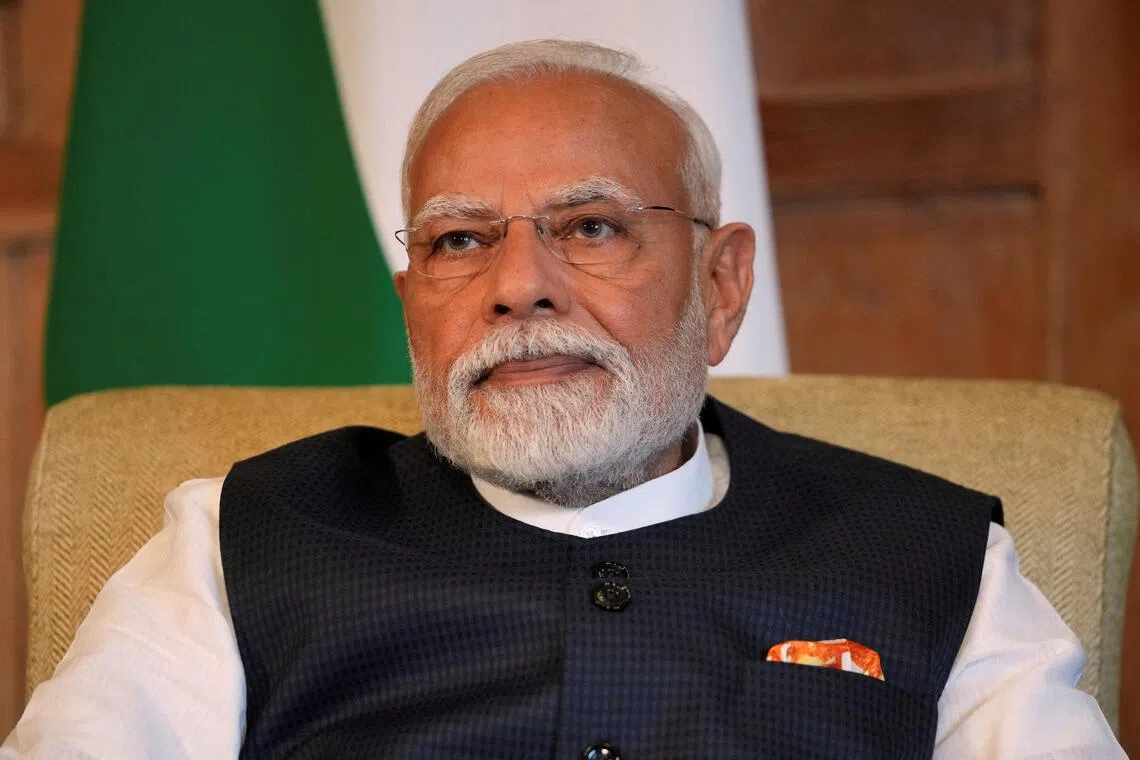Modi to skip Asean summit, but progress being made on India-Asean free-trade pact
Sign up now: Get insights on Asia's fast-moving developments

Indian Prime Minister Narendra Modi will be attending the India-Asean Summit virtually on Oct 26.
PHOTO: REUTERS
Follow topic:
NEW DELHI – Indian Prime Minister Narendra Modi may be a no-show at the Oct 26-28 Asean summit, but progress in the review of the Asean-India Trade in Goods Agreement could lead to a much-needed boost in trade after negotiations hit a rough patch earlier in 2025.
External Affairs Minister S. Jaishankar will represent India at the East Asia Summit in Kuala Lumpur,
But the Prime Minister, underlining the importance attached to India’s ties with South-east Asia, will virtually attend the Asean-India Summit on Oct 26, where the status of the trade agreement review is likely to come up during an overall assessment of ties with Asean leaders.
“Look forward to joining the Asean-India Summit virtually, and to further deepening of the Asean-India Comprehensive Strategic Partnership,” Mr Modi said on X on Oct 23, referencing a telephone conversation with Malaysian Prime Minister Anwar Ibrahim.
India had pushed for a review of the Asean-India Trade in Goods Agreement (AITIGA), which was signed in 2009. Negotiations started in 2023, with the aim of modernising the agreement and addressing issues related to market liberalisation.
Indian industries such as steel and plastics have complained that the current agreement disadvantaged them with higher tariffs. Exporters also argue that access to all Asean markets is not easy or uniform due to non-tariff barriers, especially food safety standards and certification processes affecting agriculture exports from India to Asean.
The review hit a snag in June when India’s Commerce and Industry Minister Piyush Goyal called the agreement “silly”
The remarks rattled Asean, which sought clarity on the future of the negotiations.
Mr Goyal struck a different note a month later, after meeting Malaysian Trade and Industry Minister Tengku Zafrul Aziz – Malaysia being Asean chair in 2025. He posted on X that he looked forward to “fast-tracking discussions with Asean member states to ensure fair trade and balanced growth”.
Looking east
The review matters more now for India after the US, its biggest export market, slapped it with a 50 per cent tariff in August. The country is now seeking to diversify trade partners and tap new markets.
Asean is India’s fourth-largest trading partner, with trade between the two sides reaching US$120.87 billion (S$157 billion) in the fiscal year 2023-2024.
India’s exports to Asean were valued at US$41.2 billion, while imports from Asean amounted to US$79.67 billion in 2023-2024, resulting in a trade deficit in favour of the 10-member group.
“The good thing is that in the last two months, there has been some positive movement on some of the outstanding issues on market access,” said Commerce Secretary Rajesh Agarwal, who declined to go into details of the negotiations at a recent press briefing.
“There is an asymmetry on market liberalisation between the partner countries and also other areas. We hope this forward movement will lead to some sort of conclusion,” he said. It is understood the next round of negotiations is likely to take place in November.
People with knowledge of the discussions said the two sides have more or less agreed on an updated tariff rate, but some Asean countries are seeking a longer period or graded multi-year approach to meet the tariff liberalisation rate. And this issue needs to be sorted out, they said.
India has opened 71 per cent of its tariff lines or product categories for concessions, while Asean member states offer different levels, some over 71 per cent and others less.
An official said India had submitted a counterproposal to the proposal provided by Asean.
India-US trade talks face turbulence
With the Prime Minister skipping the Asean summit, an anticipated meeting between him and US President Donald Trump will not be happening.
Ongoing trade negotiations between the two countries had been hit by Mr Trump’s repeated criticisms of India’s purchases of Russian oil, that culminated in the US’ doubling of tariffs on India to 50 per cent. India says Russian oil imports are key to the nation’s energy security.
The two sides have been narrowing differences in negotiations, including on US agricultural imports into India, where agriculture is a heavily protected sector, and Indian media say a deal is near.
Still, India has refused to confirm Mr Trump’s repeated assertions that India has agreed to reduce Russian oil purchases, and denied his claims that he negotiated a ceasefire between India and Pakistan that ended a four-day border conflict in May 2025.
“With the kind of pressure we are facing from the US, India will have to effectively look east. I won’t say it’s a decoupling from the US, but a diversification because of the kind of export dependence, with a quarter of the exports going to the US,” said Dr Biswajit Dhar, a trade economist and retired Jawaharlal Nehru University professor.
He said India would still continue to diversify even if it clinches a trade deal with the US, given the recent turn of events. “India will remain very cautious in dealing with the US and will always have its guard up.”
New Delhi clinched a trade deal with the United Kingdom in July and continues its push to reduce its export dependence on the US.
FTAs are also in various stages of negotiation with a number of countries, including Sri Lanka, Peru, New Zealand, Chile and the European Union, with experts noting that India is seeking to counter some of the tariff volatility.
Meanwhile, Indian exporters say an early conclusion of the India-Asean trade review will be a boost for them.
Seafood exporters, which have significant exposure to the US market, hope the FTA review will open up access to Asean markets.
“We are looking at diversifying to all parts of the world, and we look at Asean as a good emerging market,” said Dr K.N. Raghavan, CEO of the Seafood Exporters Association of India.
“Close to 40 per cent of our exports go to the US. So the 50 per cent tariff has hit hard. One issue is the quantum of duty, and the second is the uncertainty,” he said, noting there was no clarity on how soon the tariff rate would come down and to what quantum.
He said that the association has written to the government to include seafood, a protected sector in India, in all trade agreement negotiations including the Asean review. “You cannot put all your eggs in one basket,” he added.


